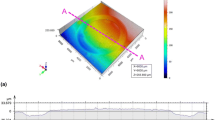Titanium-based composites containing MoS2, MoSe2, CaF2, and BN solid lubricants are synthesized. Their tribological characteristics are investigated without lubrication at different sliding velocities (0.5, 1, 2, 4, 6, and 15 m/sec) and low pressures (0.27, 0.54, 0.8, 1.1, 1.35, 1.47, and 2.7 MPa) in air. In view of the high friction coefficient and large wear, the composite materials cannot be proposed as antifriction ones for operation at small sliding velocities and low pressures. The titanium-based composites are promising as antifriction materials at an increased sliding velocity (15 m/sec) and low pressures when their friction coefficients range from 0.3 to 0.36 and wear ranges from 1.91 to 68.3 mg/km. In dry friction at a high sliding velocity in air, the temperature of their working surface increases resulting from the formation of titanium oxides and then a dense secondary lubricating microheterogeneous film. The composition and structure of the secondary films differ from those of the starting materials and determine their antifriction properties and friction performance.




Similar content being viewed by others
Notes
Secondary structural lubricating films are called secondary films here and further in the text.
References
G. I. Kapyrin, Titanium Alloys in Mechanical Engineering [in Russian], Mashinostroenie, Leningrad (1977), p. 248.
I. S. Katyug and V. I. Svitsikov, “Some friction and wear tests of titanium and its alloys,” Sudostroenie, No. 8, 46–48 (1958).
I. D. Radomysel’skii, S. V. Titarenko, A. M. Petrova, and V. V. Polotai, “Friction and wear of sintered titanium materials,” Powder Metall. Met. Ceram., 16, No. 6, 464–469 (1977).
I. M. Fedorchenko and L. I. Pugina, Sintered Composite Antifriction Materials [in Russian], Naukova Dumka, Kiev (1980), p. 440.
V. N. Miroshnikov and Yu. F. Shevchuk, “Choice of solid lubricants,” Powder Metall. Met. Ceram., 10, No. 11, 911–915 (1971).
A. G. Kostornov, O. I. Fushchich, V. F. Gorban’, et al., “Dependence of antifriction properties of self-lubricating copper-based composite on the elastoplastic characteristics of tribosynthesis region,” Powder Metall. Met. Ceram., 47, No. 11–12, 674–679 (2008).
Antifriction Powder Materials. Method of Determining Tribotechnical Properties. GOST 26614–85 [in Russian], Gosstandart, Moscow (1985), p. 9.
G. V. Samsonov, Nitrides [in Russian], Naukova Dumka, Kiev (1969), p. 380.
Author information
Authors and Affiliations
Corresponding author
Additional information
Translated from Poroshkovaya Metallurgiya, Vol. 51, No. 11–12 (488), pp. 88–99, 2012.
Rights and permissions
About this article
Cite this article
Kostornov, A.G., Fushchich, O.I., Chevychelova, T.M. et al. Prospects of Improving the Tribotechnical Characteristics of Titanium Composites. Powder Metall Met Ceram 51, 687–696 (2013). https://doi.org/10.1007/s11106-013-9484-z
Received:
Published:
Issue Date:
DOI: https://doi.org/10.1007/s11106-013-9484-z




